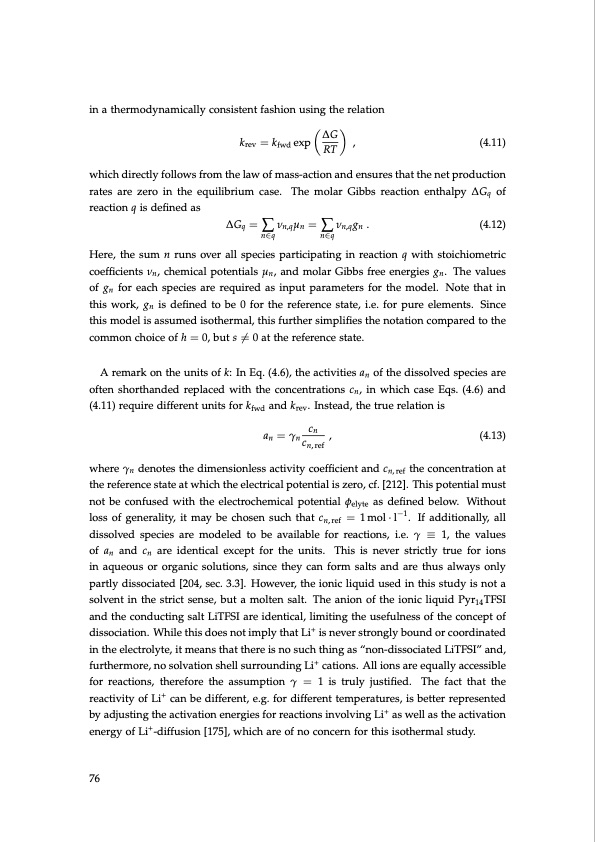
PDF Publication Title:
Text from PDF Page: 076
in a thermodynamically consistent fashion using the relation ∆G krev = kfwd exp RT , (4.11) which directly follows from the law of mass-action and ensures that the net production rates are zero in the equilibrium case. The molar Gibbs reaction enthalpy ∆Gq of reaction q is defined as ∆Gq = ∑ νn,qμn = ∑ νn,qgn . (4.12) n∈q n∈q Here, the sum n runs over all species participating in reaction q with stoichiometric coefficients νn, chemical potentials μn, and molar Gibbs free energies gn. The values of gn for each species are required as input parameters for the model. Note that in this work, gn is defined to be 0 for the reference state, i.e. for pure elements. Since this model is assumed isothermal, this further simplifies the notation compared to the common choice of h = 0, but s ̸= 0 at the reference state. A remark on the units of k: In Eq. (4.6), the activities an of the dissolved species are often shorthanded replaced with the concentrations cn, in which case Eqs. (4.6) and (4.11) require different units for kfwd and krev. Instead, the true relation is a =γ cn , (4.13) n n cn, ref where γn denotes the dimensionless activity coefficient and cn, ref the concentration at the reference state at which the electrical potential is zero, cf. [212]. This potential must not be confused with the electrochemical potential φelyte as defined below. Without loss of generality, it may be chosen such that cn, ref = 1 mol · l−1. If additionally, all dissolved species are modeled to be available for reactions, i.e. γ ≡ 1, the values of an and cn are identical except for the units. This is never strictly true for ions in aqueous or organic solutions, since they can form salts and are thus always only partly dissociated [204, sec. 3.3]. However, the ionic liquid used in this study is not a solvent in the strict sense, but a molten salt. The anion of the ionic liquid Pyr14TFSI and the conducting salt LiTFSI are identical, limiting the usefulness of the concept of dissociation. While this does not imply that Li+ is never strongly bound or coordinated in the electrolyte, it means that there is no such thing as “non-dissociated LiTFSI” and, furthermore, no solvation shell surrounding Li+ cations. All ions are equally accessible for reactions, therefore the assumption γ = 1 is truly justified. The fact that the reactivity of Li+ can be different, e.g. for different temperatures, is better represented by adjusting the activation energies for reactions involving Li+ as well as the activation energy of Li+-diffusion [175], which are of no concern for this isothermal study. 76PDF Image | Lithium-Sulfur Battery: Design, Characterization, and Physically-based Modeling

PDF Search Title:
Lithium-Sulfur Battery: Design, Characterization, and Physically-based ModelingOriginal File Name Searched:
Dissertation_David_N._Fronczek_The_Lithium_Sulfur_Battery.pdfDIY PDF Search: Google It | Yahoo | Bing
Sulfur Deposition on Carbon Nanofibers using Supercritical CO2 Sulfur Deposition on Carbon Nanofibers using Supercritical CO2. Gamma sulfur also known as mother of pearl sulfur and nacreous sulfur... More Info
CO2 Organic Rankine Cycle Experimenter Platform The supercritical CO2 phase change system is both a heat pump and organic rankine cycle which can be used for those purposes and as a supercritical extractor for advanced subcritical and supercritical extraction technology. Uses include producing nanoparticles, precious metal CO2 extraction, lithium battery recycling, and other applications... More Info
| CONTACT TEL: 608-238-6001 Email: greg@infinityturbine.com | RSS | AMP |